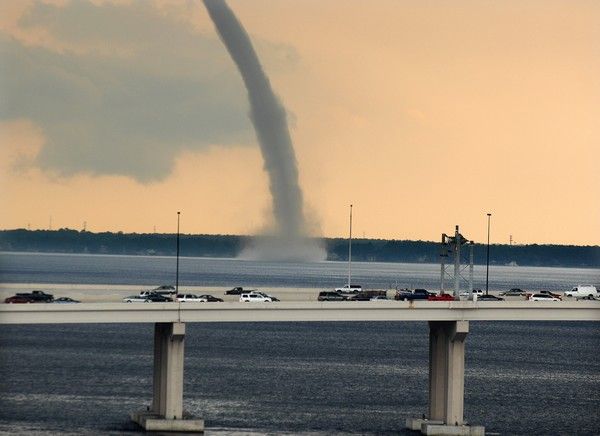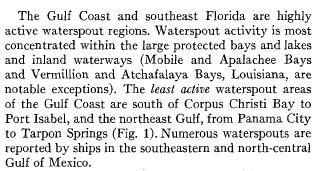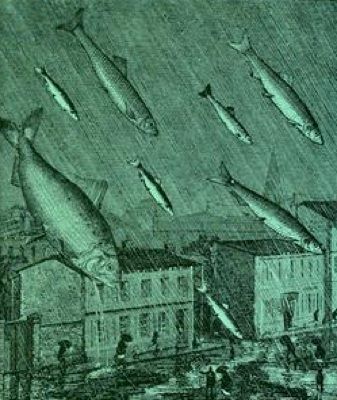It looks like you're using an Ad Blocker.
Please white-list or disable AboveTopSecret.com in your ad-blocking tool.
Thank you.
Some features of ATS will be disabled while you continue to use an ad-blocker.
4
share:
I know the subject of raining oil has been beaten to death, but I couldn't resist one more volley on the subject.
The Florida Keys "are the greatest, natural vortex lab in the world," says Joseph Golden, a senior National Oceanic and Atmospheric Administration scientist who has studied waterspouts extensively. "Waterspouts probably occur more frequently in the Florida Keys than anywhere in the world."
Waters around the Keys, especially from Marathon past Key West on westward to the Dry Tortugas, probably see 400 or 500 waterspouts a year. Since they are so common, most go unreported unless they cause damage.
...
After the Florida Keys, the next most active U.S. waterspout area is the southeast Florida Coast from around Stuart south to Homestead. Tampa Bay has the greatest number of damaging waterspouts, probably because the shores of the Bay are so built up.
Places around the Gulf of Mexico along with the Atlantic Coast northward to Chesapeake Bay are also likely to see waterspouts.
Link.
The 400-500 per year number was just for the Keys.
Similar significant activity happens all along the Gulf Coast. In fact, this 1977 scientific study Waterspout Frequencies.pdf reveals this interesting graphic:
Ironically, the study reveals a very interesting conclusion:
Ok.
Enough of that...
I think I've established an answer to the 'frequency' question.
So let's move on to my primary point:
If it can rain fish and frogs, why not oil?
It’s Raining Fish: Unusual objects sometimes fall from the sky, courtesy of waterspouts.
Just before last New Year’s Eve, Carl and Kathy Hennige of Folsom, California e-mailed their local newspaper to report some strange weather. It was raining fish.
Although it may sound like some sort of mythical event, the Henniges weren’t telling tales. Neither were people in Manna, India, who reported seeing live, pencil-sized fish falling from the sky in July. It can happen, say scientists. The culprit: waterspouts.
Waterspouts, which are essentially tornadoes over water, form when cold air moves over warm water. They churn at speeds up to 200 miles an hour, but dissipate when rain begins to fall from their host cloud. Depending on how fast the winds are whipping, anything that is within about one yard of the surface of the water, including sailboats or fish of different sizes, can be lifted into the air, says Nilton Renno, an atmospheric scientist at the University of Michigan.
A waterspout can sometimes successfully suck small objects like fish out of the water and all the way up into the cloud. Even if the waterspout stops spinning, the fish in the cloud can be carried over land, buffeted up and down and around with the cloud’s winds until its currents no longer keep the flying fish in the atmosphere. It’s like the fish are swimming in the cloud, says Renno. Depending on how far they travel and how high they are taken into the atmosphere, the fish are sometimes dead by the time they rain down. People as far as 100 miles inland have experienced raining fish, he explains.
Fish can also be sucked up from rivers. The Henniges’ condo is just one mile above Lake Natoma and the Nimbus fish hatchery, where they think the fish came from. Carl Hennige writes in an e-mail that there was “an enormous windstorm” just before the fish fell.
Raining fish is not a common weather phenomenon. Fewer than 10 occurrences have been reported in the past year, according to a news search, so local five-day forecasts probably won’t include fish showers. Still, people have reported such events for centuries.
Funny how in the context of that article, ten reported object falls in a year seems like a minor thing. But in the context of widespread liquid oil and Corexit, it seems like a HUGE number. Does anyone else agree?
Another article further explains the mechanics and possibilities:
Frogs can weigh as little as a few ounces. But even the heavier ones are no match for a watery tornado, or a waterspout, as it's called when a whirlwind picks up water. The series of events that can lead to frog rain go something like this:
A small tornado forms over a body of water. This type of tornado is called a waterspout, and it's usually sparked by the high-pressure system preceding a severe thunderstorm.
As with a land-based tornado, the center of the waterspout is a low-pressure tunnel within a high-pressure cone. This is why it picks up the relatively low-weight items in its path -- cows, trailer homes and cars get sucked up into the vacuum of the vortex. But since a waterspout is over water and not land, it's not automobiles that end up caught in its swirling winds: it's water and sea creatures.
The waterspout sucks up the lower-weight items in the body of water as it moves across it. Frogs are fairly lightweight. They end up in the vortex, which continues to move across the water with the high-pressure storm clouds. When a particularly powerful storm hits land, the waterspout might go with it.
When the storm hits land, it loses some of its energy and slows down. The pressure drops. Eventually, the clouds release the water they're carrying. As the rain falls, the vortex eventually loses all the pressure that's keeping it going, and it releases whatever it has picked up in its travels. Sometimes, this cargo includes frogs.
The end result is frog rain. Sometimes it's a few dozen frogs -- or a couple hundred or even thousands. And usually, it's not just frogs. Frogs get top billing because of their role in Exodus, but waterspouts can carry all sorts of items. So what's the strangest thing that can fall from the sky?
Frogs can travel tremendous distances in the vortex of a waterspout. Waterspouts can move across hundreds or thousands of miles, although that's extremely rare. It's more common for frogs to travel just a few miles before they fall to the ground.
Reports of strange objects falling from the sky are numerous and varied. People have reported raining squid, worms and fish. Fish are actually the most common creatures to fall from the sky, for obvious reasons -- they're very lightweight, and they're the most common water inhabitants [source: BBC]. But waterspouts can pick up heavier objects, too.
Waterspout winds can spin at amazing speeds -- up to 200 mph [source: CMMAP]. These types of wind speeds can pick up a very wide range of cargo because they can suck up objects from up to 3 feet (1 meter) below the surface, and the low-pressure core they form is an extremely powerful vacuum compared with the speeding winds surrounding it. Large water birds have also fallen from the sky. At least one source reports a sailboat coming down with rain [source: CMMAP]. Presumably a waterspout can pick up a few things when it hits land, too, because it has also been known to rain tomatoes and coal [source: CMMAP].
Link.
See also these random examples:
MYSTERIOUS FALLS
FROM THE SKY
It started out as a normal morning for A. D. Bajkov. He was eating breakfast with his wife in a restaurant in the small town of Marksville, Louisiana. Suddenly, a waitress hollered, “Quick, look! Fish are falling from the sky!” Bajkov, a wildlife biologist, ran outside to observe the strange event. The waitress was right—it was raining fishes.
Link.
Waterspouts, likely those of the tornadic variety, have been known to occasionally suck up live fish and frogs and then drop them over nearby land. In Montreal, a waterspout once rained lizards on the city. They have also showered tadpoles on New York and toads on France. A waterspout which struck Providence, Rhode Island, rained fish down on the populus who promptly gathered and sold them, a heaven-sent windfall for sure!
Link.
Five years ago Bordeaux housewives reaped a harvest of small fish swept up from the River Garonne into a water twister, carried inshore and deposited wriggling in the streets.
Link.
I could literally find thousands of examples and articles on the subject!
Even on ATS: The whole fish/frogs falling from the sky thing - Theories!
Clearly, this isn't an occasional thing.
Does this change the sense of risk for anyone?
Forget oil rain! How about oil/corexit tornadoes?
Crazy? Really?
See also:
Proof of Oil Rain?
And:
It wont rain oil....however...
And:
LAB: "This water is poisonous..."
Food for thought....food for thought.
[edit on 7-7-2010 by loam]
you are spot on the side affects of main stream media.
no they say it will never rain frogs, or fish.
when it happens, its like a "it never really happens" kind of news!
you have made a good threat!
no they say it will never rain frogs, or fish.
when it happens, its like a "it never really happens" kind of news!
you have made a good threat!
"Rain"? Hell no too common, that could happen to anyone. If there's airborn crude it'll be referred to as a "Gravity induced petroleum
incident." Man, those don't happen every day, right?
reply to post by intrepid
im sorry,
...
you forgot the dispersant mix of new age acid rain.
(with that airborne crude oil.)
"ive seen ductape flow away, without leaving any glue behind"
...
airborne dispersant and crude oil.
new age stuff i reckon.
im sorry,
airborn crude oil
...
you forgot the dispersant mix of new age acid rain.
(with that airborne crude oil.)
"ive seen ductape flow away, without leaving any glue behind"
...
airborne dispersant and crude oil.
new age stuff i reckon.
Anything is possible.
I, and a whole neghborhood of kids when I was growing up in Texas, witnessed the raining down of hundreds of very small frogs on at least 3-4 different occasions over the years.
The first time we saw it, we could hardly believe it. After that
it was just a "cool thing" to witness.
I, and a whole neghborhood of kids when I was growing up in Texas, witnessed the raining down of hundreds of very small frogs on at least 3-4 different occasions over the years.
The first time we saw it, we could hardly believe it. After that
it was just a "cool thing" to witness.
Keep an eye on the weather: Atlantic Graphical Tropical Weather Outlook. This could get pretty
darn messy. And the gulf waters are reportedly warmer than usual, so who know how that will affect these storms.
reply to post by telfyr
I don't know about that but back in the day Blood, Sweat and Tears said, "What goes up must come down......" Makes sense to me.
I don't know about that but back in the day Blood, Sweat and Tears said, "What goes up must come down......" Makes sense to me.
reply to post by intrepid
the worst can happen, expect something more bad than that, you'll be less amazed than others, when it happens.
the worst can happen, expect something more bad than that, you'll be less amazed than others, when it happens.
More:
***WARNING*** This next one is rather graphic.
Point made, I think.
"The swirling suction can lift the entire contents of a pond."
***WARNING*** This next one is rather graphic.
Point made, I think.
Technically it isn't "raining" anything but water, the fish, frogs and/or oil are just falling from the sky in the rain...
I see no reason why waterspouts or hurricanes will not possibly pick up the oil & dispersant in the Gulf of Mexico. In fact, I expect this to happen
sometime within the next couple of months. I dare not to say what may come of this.
[edit on 7-7-2010 by unityemissions]
[edit on 7-7-2010 by unityemissions]
reply to post by unityemissions
If the frequency is as described, I think it is highly likely we will see this over the next few months.
If the frequency is as described, I think it is highly likely we will see this over the next few months.
new topics
-
Famous Catholic Exorcist Visits Mir-a-Lago
US Political Madness: 3 hours ago
top topics
-
The Martian Lafayette Meteorite Interacted with Water Just 742 million years ago
Space Exploration: 17 hours ago, 7 flags -
My Body Of Release…
Philosophy and Metaphysics: 17 hours ago, 4 flags -
Famous Catholic Exorcist Visits Mir-a-Lago
US Political Madness: 3 hours ago, 3 flags -
Biden FINALLY allows Ukraine to use US missiles inside of Russia.
General Conspiracies: 12 hours ago, 0 flags
active topics
-
Well, here we go red lines crossed Biden gives the go ahead to use long range missiles
World War Three • 125 • : gortex -
Racist Text Messages Mass Distributed
Social Issues and Civil Unrest • 28 • : SideEyeEverything1 -
Post A Funny (T&C Friendly) Pic Part IV: The LOL awakens!
General Chit Chat • 7783 • : baddmove -
Con Man Don
Jokes, Puns, & Pranks • 8 • : Moon68 -
The Truth Behind the Manchester Airport "Police Assault" Video
Social Issues and Civil Unrest • 39 • : gortex -
POLLS - Leading Up To The November 2024 USA Elections.
2024 Elections • 323 • : NoCorruptionAllowed -
Former DOJ charged with defrauding Rep. Matt Gaetz’s family over sex-crimes investigation
Propaganda Mill • 25 • : fringeofthefringe -
The Change I Want To See
Rant • 64 • : doctordark -
WATCH LIVE: US Congress hearing on UFOs, unidentified anomalous phenomena
Aliens and UFOs • 107 • : Lazy88 -
Famous Catholic Exorcist Visits Mir-a-Lago
US Political Madness • 1 • : FlyersFan
4






